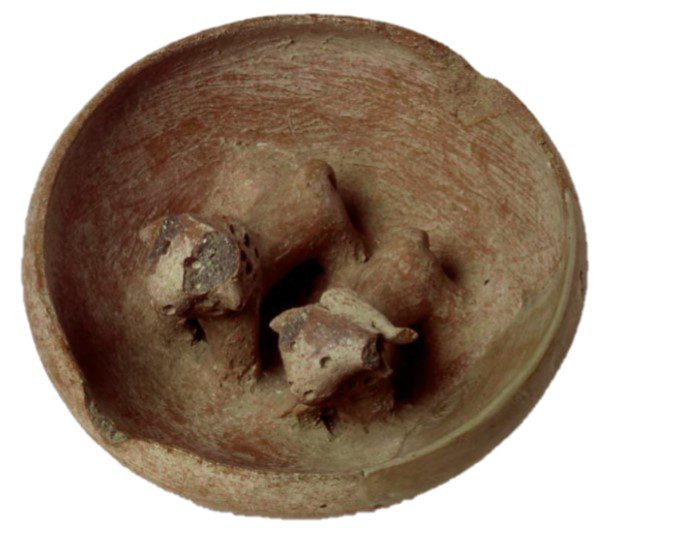Tel al-Fa’a North is identified with Tirzah, which was a Canaanite and then an Israeli city. Served for a certain period as the capital of the Kingdom of Israel.
The hill dominates a landscape that is breathtaking in its beauty and abundant with water, rising between two springs: Ein al-Fara’a and Ein al-Sultan. Its location is at the head of a wide and fertile valley that descends to the Jordan Valley, and in it flows Wadi Pera’ah to the Jordan. The size of the biblical city is about 80 dunams. The Song of Songs refers to the beauty of Tirzah: “My wife is as beautiful as Tirzah, and Jerusalem is as terrible as the stars.”
The mound is mentioned in the British survey as Tell El Far’ah, previously surveyed by: Gren, Robinson, the British survey, Albright and Adam Zartel. Conder and Kitchener of the British survey suggested that Tirzah is in the nearby town of Thiyasir. Robinson and Gren proposed to identify the city with the nearby town, Talloza. Albright identified Tel El Pharaoh North as Tarzah. This identification was received after the excavations of the French expedition and is currently accepted in research.
The story of Tersha in the Bible:
Tirzah is mentioned for the first time in the book of Joshua as a Canaanite city, whose kingdom was one of the 31 kings of Canaan “whom Joshua and the children of Israel struck across the Jordan River”, and after the conquest it was included in the tribe of Manasseh.
Trisha, is mentioned as a young woman among the daughters of Zalfahad ben Hefer. The name Tirzah is mentioned in the Samarian pottery (Somarian Ostrocones).
The city became the capital of the Kingdom of Israel in the days of Jeroboam ben Nebat. His son, Nadav, was murdered by Baasha, who reigned for 24 years, and continued to build the city. Baasha’s son, Elah is mentioned as a debaucherous and drunken king. After two years of his ascension to the Zmari kingship, the soft half of the song was tied up and killed. Zimri king of seven days. Omri, the minister of half the group, complained about the city and in response Zimri set himself on fire in the “King’s House”. The city was conquered by Omri in 885 BC.
It is possible that the citadel in the northwest corner of the mound is the Zimri Palace. Omri fought for 4 years in Tabani Ben Ginat until he ascended to the throne. After the conquest of Omri, the city was rebuilt. Omri stayed in Terza for six years and then moved the royal city to Samaria.
One of the last kings who reigned in Israel, Menachem ben Gadi, came from Tirzah: “And Menahem ben Gadi went up from Tirzah and came to Samaria and killed Shalom ben Yabish in Samaria and they died and he reigned under him.”
At the end of the kingdom of Israel, an Assyrian siege was imposed on Samaria and Terzah. The city fell to the Assyrians in 722 BC, and since then Tirzah has disappeared from the stage of history.
The excavations at the site:
The excavations at Tel El Phareah were conducted by the French father De Vaux in the years 1960-1946. It was discovered that the mound was inhabited from the Neolithic period in the 8th millennium BC until the 3rd century BC. A city from the Early Bronze Age 1-2 was uncovered. In the Middle Bronze Age 2B the city was fortified, large fortifications were found from it: a wall and a 2-cell gate that continued to be used even in the Iron Age. In the Late Bronze Age the city shrank, and in the Iron Age 1 the settlement is still small. Houses and streets dating to the 11th century BC were uncovered from it. From the 10th and 9th centuries BC, pottery with multiple seals and a model of a temple, metal tools and more were found. A handle of a jug of the “Lamelech” type was found and on it is written in ancient Hebrew “Leshmirio”. Several cemeteries and tombs dating back to the 7th – 8th centuries BC were uncovered around the mound. The findings show that during the days of the Kingdom of Israel the settlement of Tel el Phareah was of great importance, and its material culture reached its peak at the beginning of the ninth century BCE – the days of Beit Basha’s reign. She stood, according to the Bible, at the height of her greatness. It should be noted that the archaeological findings of Terza fit the biblical story.
Father de Vo adds that: “In the layers that have been revealed, you can see the words of the days of Tirzah, as they are told in the Bible.”
Sources:
Tel El Pharoah – Tirzah in the mandatory archive of the Antiquities Authority.
De Vaux R. (1952) LA QUATRIÈME CAMPAGNE DE FOUILLES A TELL EL-FAR’AH, PRÈS NAPLOUSE. Revue Biblique.
Finkelstein I. 2012. TELL EL-FAR’AH (TIRZAH) AND THE EARLY DAYS OF THE NORTHERN KINGDOM. Revue Biblique Vol. 119, No. 3, pp. 331-346 (16 pages).
Zertal A. 2004. The Manasseh Hill Country Survey, Volume I: The Shechem Syncline, Volume III.












